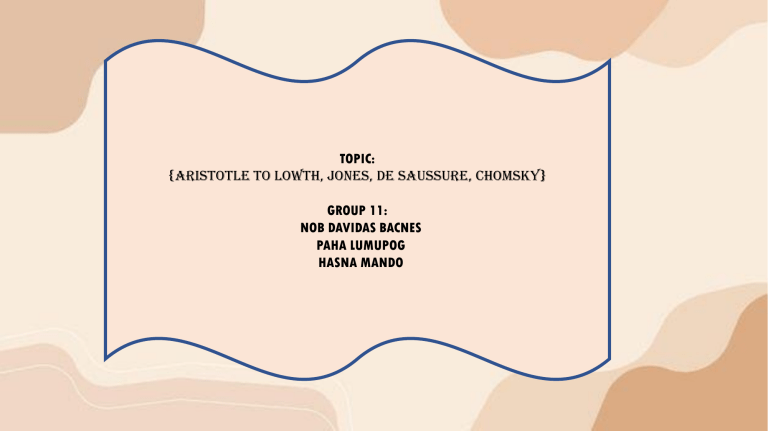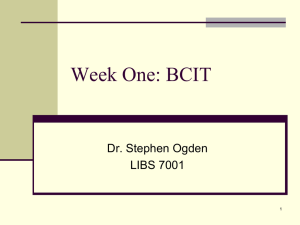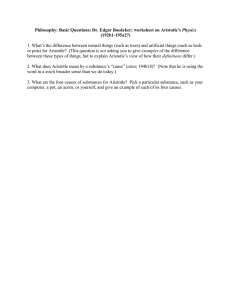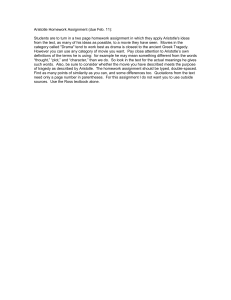
TOPIC:
{ARISTOTLE TO LOWTH, JONES, DE SAUSSURE, CHOMSKY}
GROUP 11:
NOB DAVIDAS BACNES
PAHA LUMUPOG
HASNA MANDO
OBJECTIVES FOR GROUP 11-15:
At the end of these weeks, the Pre-service teacher (PST) should be able to:
a. identifies noteworthy linguists and their contributions to language that it is today;
b. traces the development of language and the English language in a historical
perspective from AngloSaxon to global periods;
c. recognizes the language family of English including the modern foreign languages
related to it in phonology, morphology, syntax, and semantics;
d. differentiates the three Englishes according to time period – Old, Middle, and Modern
– through in-depth historical linguistics analysis case; and
e. analyzes the changes of English from Old to Modern through tracing Grimm’s Law
and the Great Vowel Shift in sample discourses.
Objectives;
At the end of the discussion, the students should be able to:
Understand the history of aristotle to lowth jones de saussure and chomsky
Differentiate the contribution of aristotle to lowth and jones de saussure and chomsky
Describe individual history of life.
Defined the History of English
Indo-European language family
Old English
with these anglo-saxons our story truly begins
The Anglo-Saxons and their many kingdoms spoke a language we
now called old English.
Example;
Hwæt. We Gardena in geardagum,
peodcyninga, þrym gefrunon,
hu ða æpelingas ellen fremedon.
Old English is not a static language no languages ever are but the most of the
major changes to the English language through its history came not from within
but from without.
the first major influx of change to English came with the Viking invasions in the 8th
century onward.
Old Norse- which the ancestors of the modern Scandinavian languages
Middle English
William the bastard later called William the conqueror in 1066 he invaded England with his
Norman army and the battle of hastings successfully conquered it. These Normans now
the ruling class of England spoke a dialect of old French.
After around 100 years Old English and Norman French begins to merge, creating what
we called Middle English.
Synonyms- is the French connection is also why English has so many words that mean
the same thing.
Middle English is one step closer to the language we know today still it
is by and large incomprehensible to most English speakers.
Example from the Canterbury tales by Chaucer the most famous Middle English writer
Whan that Aprille, with his shoures soote
The droghte of March hath perced to the roote
And bathed every veyne in swich licour,
Of which vertu engendred is the flour;
Early Modern English
In the 15th Century a phenomenon known as the great vowel shift started Occuring which propelled
English into its early modern version this vowels shift affected almost all English pronunciation in
quite dramatic ways.
English long vowels like “Oo” started becoming shorter diphthongs like “oh”, and also there were
many consonants that became unpronounced which we call now Silent Letters.
Example: Knife
With this change over around 200 years the English language landed in a place most of us will
recognize.
Example: Two households, both alike in dignity (In fair Verona, where we lay our scene), From ancient
grudge break to new mutiny, where civil blood makes hands unclean.
Beginning in the 16th century the British started exploring and subsequently created an
empire at its height in the 19th century the British empire covered a quarter of the earth and
had controlled over almost of the earth's inhabitants. This spread of English as well as the
later industrial revolution transformed English further. Mostly in the realm of vocabulary
Colonial
Jungle
Hammock
Pajamas
Hurricane
Industry
Train
Engine
Combustion
Piston
Aristotle was born Stagira, in ancient macedonia, in #384 BCE. An Ancient Greek philosopher and a
scientist, Aristotle is the person behind the Demomythlogization of language. He defined language as
an object of rational inquiry.
Semiotic Traingle- is language as expression of thoughts that are intentionally related with elements in
our world
Contributions of Aristotle
-Provided the first semantic analysis of propositions.
-He produced the term 'case' for paradigmatic morphological variation.
-He defined the basic components of sentences: the name and verb (or subject and predicate)
-HE analyses the 'world' as consisting of things that are named by any of the 10 categories: substance,
quantity, quality, relation, place, time, position, state, action, or affection.
ARISTOTLE
[384-322 B.C]
MODEL OF COMMUNICATION
Aristotle developed a linear model of communication for oral communication known as
Aristotle model of communication. This is considered as the first model of communication
and was proposed before 300 B.C. It is also the most widely accepted among all
communication models. Aristotle model is mainly focused on speaker and speech . It can
be broadly divided into 5 primary elements,
1] Speaker
2] speech
3] Occasion
4] Audience
5] Effect
The Aristotle communication model is a speaker centered model as the speaker has the
most important role in it and is the only one active. it is the speakers role to deliver a
speech to the audience. role of the audience is passive, influenced by the speech. This
makes the communication process one way from speaker to receiver.
ROBERTBLOWTH
[1710-1787]
PRESCRIPTIVE GRAMMAR
Following the curious description of Robert Lowth [1710-87] as a philologist more inclined to melancholy
than to mirth; the oxford companion to the English language [OCEL] notes that Lowths name has
become synonymous with prescriptive grammar [ McArthur 1992; s.v Lowth].Lowth's short introduction to
English grammar was first publish in 1762, and was frequently reprinted during the eighteenth century.
Linguistic prescription, or prescriptive grammar , is the attempt to established rules defining preferred or
correct usage of language. These rules may address such linguistics aspect as spelling, pronunciation,
vocabulary, syntax, and semantics. sometimes informed by linguistic purism, such normative practices
may suggest that some usages are incorrect, inconsistent, ilogical, lack communicative effect, or are of
flow aesthetic value. They may also include judgement or socially proper and politically correct language
use.
SIR WILLIAM JONES
[1746-1794]
A GRAMMAR OF THE PERSIAN LANGUAGE
In 1771, he published A grammar of the Persian language, which prove to be one of the best grammar
text ever published in English about a language the western world considered "exotic". For the project,
jones employed numerous literary quotations in his goal of producing scholarly work that would be
morally uplifting, and that would entertain as well as instruct. The work, which went through several
editions and translation, provided a model that later language scholars would follow.
FERDINAND DE SAUSSURE
[1857-1913]
LINGUISTICS SIGNS
Swiss linguist Ferdinand de Saussure is widely considered to be one of the forefathers of both
linguistics and semiology, which is the philosophical study of the interpretation of sign and symbols.
Most notably, Saussure introduced the idea that every word is a linguistic sign, which consist of two
components; the signifier, or the phonetic form of a word. Crucially, Saussure articulated the
arbitrariness of the linguistic sign the phonetic form and the underlying concept of the word "dog"
have no natural link, and instead are the product of social interaction. The arbitrariness of meaning
and form is a fundamental tenet of modern linguistics.
NOAM CHOMSKY
[1928]
UNIVERSAL GRAMMAR
Probably the best known on the list, Noam Chomsky is famous for many things. But the realm of
linguistic, he most famous for his idea of universal grammar, which posses that all languages have
the same underlying structure, and simply use different words and sounds on the surface. Humans,
Chomsky claims, are biologically equipped with a language acquisition device, which endows us
with the innate ability to learn language.
References;
https://youtu.be/0rUGuis1SO0
https://youtu.be/y7f5PR_WIzE
https://youtu.be/y7f5PR_WIzE
https://youtu.be/Hdn-gwLgj80
https://l.facebook.com/l.php?u=https%3A%2F%2Fyoutube.com%2Fwatch%3Fv%3DMnLE12DObOg%2
6feature%3Dshare%26fbclid%3DIwAR1cg5S_45oYOcchxxwCSlF38WMaaaqbZGypKBOyh50glNs0odumVi7-g&h=AT3SIm4GY4OPul2Blk8OJ4rs4XfaL_2qX97HIzqeSLhsd_awqTkQIYfew95nMutq0jicssANDUvqQOBesYcun2APjOyy3r4vBWeLtwCQxDgqUPsHp5xAA6UhSnfNNym8C0yw
https://youtu.be/iSSTv8-2358






